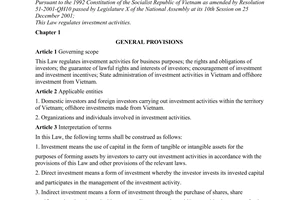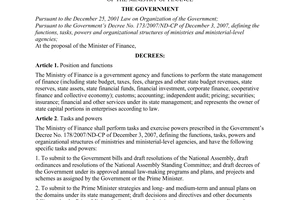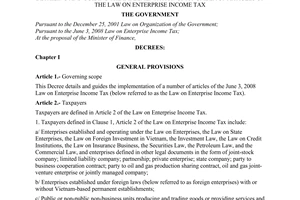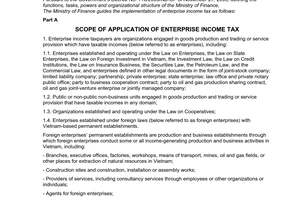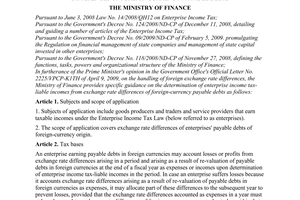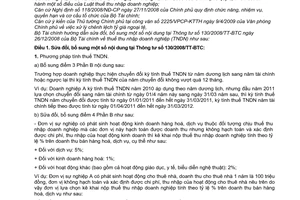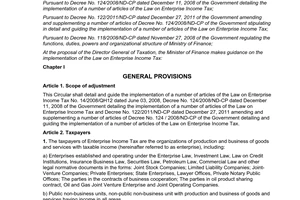Circular No. 18/2011/TT-BTC amending and supplementing the Finance Ministry's đã được thay thế bởi Circular No. 123/2012/TT-BTC guidance Law on Enterprise Income Tax và được áp dụng kể từ ngày 10/09/2012.
Nội dung toàn văn Circular No. 18/2011/TT-BTC amending and supplementing the Finance Ministry's
|
THE
MINISTRY OF FINANCE |
SOCIALIST
REPUBLIC OF VIET NAM |
|
No. 18/2011/TT-BTC |
Hanoi, February 10, 2011 |
CIRCULAR
AMENDING AND SUPPLEMENTING THE FINANCE MINISTRY'S CIRCULAR NO. 130/2008/TT-BTC OF DECEMBER 26, 2008, GUIDING A NUMBER OF ARTICLES OF LAW NO. 14/2008/QH12 ON ENTERPRISE INCOME TAX, AND THE GOVERNMENT'S DECREE NO. 124/2008/ND-CP OF DECEMBER 11, 2008, DETAILING A NUMBER OF ARTICLES OF THE LAW ON ENTERPRISE INCOME TAX
Pursuant to June 3, 2008 Law
No. 14/2008/ QH12 on Enterprise Income Tax;
Pursuant to November 29, 2006 Law No. 78/ 2006/QH11 on Tax Administration;
Pursuant to the Government's Decree No. 124/200S/ND-CP of December 11, 2008,
detailing a number of articles of the Law on Enterprise Income Tax;
Pursuant to the Government's Decree No. 118/2008/ND-CP of November 27, 2008,
defining the functions, tasks, powers and organizational structure of the
Ministry of Finance;
Pursuant to the Prime Minister's opinions in the Government Office's Official
Letter No. 2225/VPCP-KTTH of April 9, 2009, on handling of foreign exchange
rate differences.
The Ministry of Finance guides amendments and supplements to a number of
provisions of Circular No. 130/2008/TT-BTC of December 26, 2008, on enterprise
income tax (EIT), as follows:
Article 1. To amend and supplement a number of provisions of Circular No. 130/2008/TT-BTC
1. EIT calculation methods
a/ To add the following to Point 3, Part B:
In case an enterprise changes its EIT period from calendar year to fiscal year or vice versa, an EIT period in the year of change must not exceed 12 months.
Example: In 2010, enterprise A uses the calendar year as its EIT period but at the beginning of 2011, it changes to use a fiscal year from April 1 of this year to March 31 of the subsequent year, then the EIT period in the year of change will be counted from January 1, 2011, through March 31,2011, and the subsequent EIT period will be counted from April 1, 2011, through March 31,2012.
b/ To amend and supplement Point 4, Part B as follows:
- Non-business units trading in goods or providing services liable to EIT that can account turnover but cannot account and determine expenses for and incomes from this business activity, shall declare and pay EIT at a percentage of the goods sale or service provision turnover, specifically:
- For service provision: 5%;
- For goods trading: 1%;
- For other activities (including education, healthcare and art performance activities): 2%.
Example: Non-business unit A leases houses with an annual turnover of VND 100 million. As it cannot account and determine expenses for and incomes from such lease, it may select to declare and pay EIT at a percentage of the goods sale or service provision turnover as follows:
Payable EIT amount = VND 100 million x 5%= VND 5 million
2. Deductible and non-deductible expenses upon taxable income determination
a/ To add the following to Point 2.1, Section IV, Part C:
a1/ A dossier for asset and goods losses caused by natural disaster, epidemic or fire and accounted as deductible expense comprises:
- The enterprise's written explanation about asset or goods losses, addressed to the managing tax office,
- The enterprise's record of the inventory of the value of lost assets or goods.
Such record must indicate the value of lost assets or goods, reasons for such losses, responsibilities of organizations and individuals for the losses; kinds, quantity and value of recoverable assets and goods (if any), enclosed with asset or goods dossiers; and contain a statement of warehoused, ex-warehoused or in-stock goods which suffer the losses, certified and signed by the enterprise's lawful representative who shall take responsibility before a competent authority.
- A written certification of the occurrence of the natural disaster, epidemic or fire, given by the commune-level administration of the locality in which the natural disaster, epidemic or fire occurs.
- A dossier of compensation for losses for which the insurance agency accepts compensation (if any).
- A dossier defining the responsibilities of compensation payers (if any).
a2/ Goods damaged upon their expiration or due to natural biological and chemical changes which are ineligible for compensation and within the limits set by an enterprise may be accounted as deductible expense upon taxable income determination. For goods damaged upon their expiration or due to natural biological and chemical changes which exceed the limits set by an enterprise, the excessive volume may not be accounted as deductible expense upon taxable income determination.
A dossier for goods damaged upon their expiration or due to natural biological and chemical changes which are accounted as deductible expense comprises:
- The enterprise's written explanation about the damaged goods which are within the limit set by the enterprise, addressed to the managing tax office.
- The enterprise's record of the inventory of the value of the damaged goods.
Such record must indicate the value of damaged goods and reasons for such damage; kinds, quantity and value of recoverable goods (if any); and contain a statement of warehoused, ex-warehoused and in-stock goods which suffer the damage, certified and signed by the enterprise's lawful representative who shall take responsibility before a competent authority.
- A dossier for compensation for damage for which the insurance agency accepts compensation (if any).
A dossier defining the responsibilities of compensation payers (if any).
The enterprise shall send to the managing tax office a written explanation about assets or goods losses caused by natural disaster, epidemic or fire; or goods damaged upon their expiration or due to natural biological and chemical changes, which are ineligible for compensation not later than the time of submitting the E1T declaration and settlement dossier in the year when the losses occur or damage occurs. Other dossiers (such as the inventory record; written certification given by the local administration; a dossier of compensation for losses for which the insurance agency accepts compensation (if any); a dossier defining the responsibilities of compensation payers (if any); and other documents) shall be kept at the enterprise and produced to the tax office upon request.
b/ To amend and supplement Point 2.2, Section IV, Part C as follows:
- The enterprise shall notify the managing tax office of the selected fixed-asset depreciation method before applying it (e.g., the straight-line depreciation method). Annually, the enterprise shall itself decide on the level of fixed asset depreciation under the Finance Ministry's current regulations on management, use and depreciation of fixed assets, including rapid depreciation.
- In case fixed assets owned by the enterprise, which are currently used for production and business activities, are left idle for under 9 months due to seasonal production, or for under 12 months for repair, relocation or regular maintenance or servicing, then further used for production and business activities, the enterprise may. in this idleness duration, conduct depreciation and account the fixed asset depreciation expense as deductible expense upon taxable income determination.
The enterprise shall send to the tax office a notice indicating reasons for the idleness of fixed assets not later than the time of submitting the EIT declaration and settlement dossier in the year when assets are left idle.
- Permanent land use rights may not be depreciated as deductible expense upon taxable income determination. Time land use rights, if accompanied by adequate invoices and documents and lawfully established, which are involved in production and business activities, may be gradually amortized as deductible expense in the prescribed land use duration.
- In case the enterprise buys tangible fixed assets being houses or architectural objects associated with permanent land use rights, land use rights must be separately determined and accounted as intangible fixed assets, while the historical cost of houses and architectural objects is the actual buying price plus (+) expenses directly related to the putting of these tangible fixed assets into use.
+ If added-value invoices of assets bought by organizations or individuals indicate the value of I and use rights, this value is an intangible fixed asset which must not be depreciated and accounted as deductible expense.
+ If assets bought by households or individuals are not accompanied by added-value invoices, the value of land use rights is an intangible fixed asset which must not be depreciated and accounted as deductible expense. The value of land use rights shall be determined based on market prices which must not be lower than land prices set by provincial-level People's Committees at the lime of asset purchase.
c/ To amend and supplement Point 2.3, Section IV. Part C as follows:
Enterprises shall themselves set and manage consumption limits for raw materials, materials, fuels, energy or goods used for production and business activities from the beginning of a year or a period of manufacture and keep these limits at their offices, and produce them to tax offices upon request.
Particularly, enterprises shall notify main consumption limits of their major products to managing tax offices within 3 months after they commence production and business. Enterprises shall decide on lists of main consumption limits of their major products.
In the course of production and business, if enterprises adjust and add material consumption limits already notified to tax offices, they shall notify such adjustment and addition to managing tax offices by the deadline for submitting EIT settlement declarations in the year of tax settlement. If consumption limits for some raw materials, materials, fuels or goods have been set by the State, such limits shall be applied.
d/ To amend and supplement Point 2.5, Section IV, Part C as follows:
dl/ To amend Point 2.5b, Section IV, Part C as follows:
The following may not be accounted as deductible expenses: Bonuses to laborers for which the payment conditions and levels are not specified in labor contracts; collective labor agreements; financial regulations of companies, corporations or groups; or reward regulations issued by chairpersons of Boards of Directors, directors general or directors under financial regulations of companies or corporations.
d2/ To amend and supplement Point 2.5c, Section IV, Part C as follows:
- In case an enterprise makes deductions for setting up a provision fund for addition to the subsequent year's salary fund to ensure uninterrupted payment of salaries and not for any other purposes, it may set up this provision fund which must not exceed 17% of its realized salary fund.
The realized salary fund is total salaries actually paid in the year of lax settlement to the deadline for submitting tax settlement dossiers under regulations (exclusive of the amount deducted for setting up the previous year's salary provision fund and paid in the year of tax settlement).
- In case an enterprise's salary fund has been approved under regulations, the setting-up of the salary provision fund must ensure that the deducted amount plus total salaries and wages actually paid by the deadline for submitting tax settlement dossiers must not exceed total salaries and wages payable to laborers within the approved salary fund (if any).
- The setting-up of a salary provision fund must ensure that an enterprise does not suffer losses after such setting-up. The loss-suffering enterprise may not fully deduct 17% of its realized salary fund.
Example: Enterprise A's approved 2011 salary fund payable to its laborers is VND 10 billion:
+ Case 1: In 2011, enterprise A paid VND 8 billion in salaries, wages and allowances to its laborers. By the end of December 31, 2011, it has VND 2 billion left. In the first quarter of 2012, enterprise A further uses VND 300 million from the 2011 salary fund lo pay salaries and wages of 2011. So, by the deadline for submitting tax settlement dossiers, the 2011 realized salary fund is VND 8.3 billion. To ensure uninterrupted payment of salaries in the subsequent year, enterprise A may set up a salary provision fund of at most:
VND 8,3 billion x 17% = VND 1.411 billion.
The total salary amount to be accounted as expense upon determination of taxable income in 2011 is:
VND 8.3 billion + VND 1.411 billion =VND 9.71I billion.
+ Case 2: By the end of March 31, 2012, enterprise A pays a total of VND 9.5 billion in salaries and wages in 2011 and the first quarter of 2012. To ensure uninterrupted payment of salaries, it may set up a salary provision fund of at most;
VND 9.5 billion x 17% = VND 1.615 billion.
The total salary amount in 2011, which equals 17% of the realized salary fund, is VND 9.5 billion + VND 1.615 billion = VND 11.115 billion.
However, the approved salary fund is VND 10 billion, so the total salary amount to be accounted as expense upon determination of taxable income in 2011 will be VND 10 billion.
- In case in a year an enterprise sets up a salary provision fund but by December 31 of the subsequent year it has not yet used or not used up this fund, it shall record a decrease in the subsequent year's expenses.
Example: When submitting the 2011 tax settlement dossiers, enterprise B sets up a salary provision fund of VND 10 billion. By December 31, 2012, it has paid only VND 7 billion from this fund. So it shall record VND 3 billion (VND 10 billion - VND 7 billion) as a decrease in its salary expenses of the subsequent year (2012). When making the 2012 tax settlement dossiers, enterprise B may set up a salary provision fund under regulations if it so wishes.
d3/ To add the following to Point 2.5. Section IV, Part C:
- In case labor contracts signed between enterprises and foreign laborers indicate school fees for foreign laborers' children studying at general education schools in Vietnam to be paid by enterprises as amounts of salary or wage nature, if these amounts comply with regulations on salaries and wages and are accompanied by adequate documents, they will be accounted as deductible expenses upon taxable income determination.
- In case labor contracts signed between enterprises and laborers indicate house rents to be paid by enterprises for laborers as amounts of salary or wage nature, if these amounts comply with regulations on salaries and wages and are accompanied by adequate documents, they will be accounted as deductible expenses upon taxable income determination.
e/ To amend and supplement Point 2.6, Section IV, Part C as follows:
The following may not be accounted as deductible expenses: In-kind expense for laborers' uniforms without invoice or document; in-cash or in-kind expense for laborers' unifonns in excess of VND 5 (five) million/person/year.
In case an enterprise pays expenses for laborers' uniforms both in cash and in kind, the maximum expense to be accounted as deductible expense upon taxable income determination must not exceed VND 5 (five) million/person/ year.
For special business lines, such expense shall be accounted under the Finance Ministry's specific regulations.
g/ To amend and supplement Point 2.9, Section IV, Part C as follows:
The following may not be accounted as deductible expenses: Travel allowances paid for leave in contravention of the Labor Code; allowance amounts paid to laborers on domestic or overseas work trips in excess of twice the limit set by the Ministry of Finance for stale cadres, civil servants and public employees.
Travel expenses and accommodation rents for persons on work trips, with adequate lawful invoices and documents, will be accounted as deductible expenses upon taxable income determination. In case an enterprise pays travel expenses and accommodation rents in lump sum for laborers, those expenses and rents paid in accordance with the Finance Ministry's regulations applicable to state cadres, civil servants and public employees will be accounted as deductible expenses.
h/ To amend Point 2.11, Section IV, Part C as follows:
The following may not be accounted as deductible expenses: Deductions for contributing to compulsory insurance funds and trade union dues for laborers in excess of prescribed levels. Contributions to higher-level management funds in excess of levels set by superior management agencies; and contributions to funds of associations (which are lawfully set up) in excess of levels set by these associations.
Contributions to higher-level management funds are contributions made by enterprises of state economic groups or state-owned one-member limited liability companies established under regulations of competent state agencies; contributions made by enterprises of corporations established under the Prime Minister's Decisions 90 and 91; and contributions made by enterprises attached to ministries.
i/ To amend and supplement Point 2.1 S, Section IV, Part C as follows:
The following may not be accounted as deductible expenses: Expenses pie-deducted for a certain period which have not yet been paid or fully paid by the end of the period.
Pre-deducted expenses include those for cyclic overhaul of fixed assets and for activities for which turnover has been accounted but contractual obligations have not yet been fulfilled, and other pre-deducted amounts.
In case EIT liable turnover has been recorded for enterprises' production and business activities but all arising expenses are not yet paid, these expenses will be pre-deducted as deductible expenses in proportion to such turnover. Upon completing contracts, enterprises must calculate, adjust and accurately determine payable EIT amounts based on actual lawful invoices and documents under regulations.
For fixed assets requiring cyclic repair, enterprises may pre-deduct estimated repair expenses as annual expenses. If actually paid expenses are larger than pre-deducted ones, enterprises may additionally account the difference as deductible expense.
j/ To amend Point 2.20, Section IV, Part C as follows:
The following may not be accounted as deductible expenses: Foreign exchange rate difference loss resulting from the re-valuation of year-end balances being cash, deposits, money in transfer and receivable debts of foreign currency origin; exchange rate difference loss arising in the course of capital construction investment for the formation of fixed assets which are not yet put into production and business (regardless of whether or not enterprises commence production and business).
k/ To add the following to Point 2.30, Section IV, Part C:
When commencing production and business activities, if enterprises have not generated turnover but have paid regular expenses for maintaining such activities (other than expenses for construction investment for the formation of fixed assets) and these expenses satisfy the prescribed conditions, they may account them as deductible expenses upon taxable income determination.
1/To supplement Point 2.31, Section IV, Part C as follows:
- Personal income tax not accounted as deductible expense upon taxable income determination is the tax amount withheld by enterprises from taxpayers' income for remittance into the state budget. In case labor contracts signed by enterprises stipulate that salaries and wages of laborers are exclusive of personal income tax, the personal income tax to be paid by enterprises on behalf of laborers is the salary expense accounted as deductible expense upon taxable income determination.
- EIT paid on behalf of foreign contractors (contractor tax) will be accounted as deductible expense upon taxable income determination in case it is agreed in foreign contractor/ subcontractor contracts that turnover recorded by foreign contractors/subcontractors is exclusive of EIT (contractor tax).
3. Determination of incomes
a/ To add the following to Point 5. Section V, Part C:
- In case revenues from deposit or loan interests are higher than prescribed expenses for loan interests, after offsetting, the difference shall be accounted as other income upon taxable income determination.
- In case revenues from deposit or loan interests are lower than prescribed expenses for loan interests, after offsetting, the difference shall be accounted as deductible expense upon taxable income determination.
b/ To amend and supplement Point 6, Section V, Part C as follows:
- In a tax year, if an enterprise has an exchange rate difference arising in the period and an exchange rate difference resulting from re-evaluation of payable debts of foreign currency origin at the end of a fiscal year:
+ The arising exchange rate difference directly related to turnover and expenses of the enterprise's major production and business activities shall be accounted as expense or income of such activities. For the arising exchange rate difference unrelated to turnover and expenses of the enterprise's major production and business activities, if loss occurs, such difference shall be accounted as expense for such activities, if profit is earned, such difference shall be accounted as other income.
+ The exchange rate difference interest resulting from re-evaluation of payable foreign currency debts at the end of a fiscal year shall be cleared against the exchange rate difference loss resulting from re-evaluation of payable foreign currency debts at the end of that year. After clearing, the profit shall be accounted as other income, and the loss, as production and business expense, upon taxable income determination.
In case the exchange rate difference resulting from re-evaluation of payable foreign currency debts is accounted as expense, making an enterprise suffer a loss, part of such difference may be distributed for the subsequent year so that the enterprise does not suffer a loss provided that, the exchange rate difference accounted as expense in a year at least equals the exchange rate difference of the mature foreign-currency amount in that year.
The above exchange rate differences are exclusive of the foreign exchange rate difference resulting from re-evaluation of year-end balance being cash, deposits, money in transfer and receivable debts of foreign currency origin; and the exchange rate difference arising in the course of capital construction investment for the formation of fixed assets which are not yet put into production and business activities (regardless of whether or not enterprises commence production and business activities).
- Income from foreign currency trading activities is the total sales of foreign currencies minus (-) the total purchase price of the sold foreign currencies.
c/ To amend and supplement Point 11, Section V, Part C as follows:
In case an enterprise's revenue from fines or damages paid by its partner breaching the contract is higher than the expense for fines or damages for contract breaches (such fines are other than fines for administrative violations under the Ordinance on Handling of Administrative Violations), after clearing, the difference shall be accounted as other income.
In case an enterprise's revenue from fines or damages paid by its partner breaching the contract is lower than the expense for fines or damages for contract breaches (such fines arc other than fines for administrative violations under the Ordinance on Handling of Administrative Violations), after clearing, the difference shall be accounted as a decrease in other income. If no other income arises in a year, such difference shall be accounted as a decrease in production and business income.
d/ To amend and supplement Point 16, Section V Part C as follows:
Income from the sale of scraps and discarded products is income from the sale of scraps and discarded products minus recovery expense and expense for sale of scraps and discarded products.
- In case an enterprise has an-income from the sale of scraps and discarded products created during the production of products currently eligible for E1T incentives, such income will be eligible for EIT incentives.
- In case an enterprise has an income from the sale of scraps and discarded products created during the production of products ineligible for EIT incentives, such income will be ineligible for EIT incentives and shall be accounted as other income.
e/ To add the following to Section V, Part C:
The refunded amount of import duty or export duty on goods actually imported or exported in the year of EIT settlement shall be accounted as a decrease in expenses. The refunded amount of import duty or export duty on goods actually imported or exported in previous years of EIT settlement shall be accounted as other incomes. The amount which is directly related to production and.business activities currently eligible for EIT. incentives will be eligible for EIT incentives. The amount which is unrelated to production and business activities eligible for EIT incentives will be ineligible for EIT incentives and shall be accounted as other income.
4. Determination and carry forward of losses
To amend and supplement Point 2, Section VII. Part C as follows:
- After tax settlement, a loss-suffering enterprise shall wholly and consecutively carry forward losses to subsequent years' taxable incomes. The maximum duration for loss carry forward is 5 consecutive years, counting from the year following the year the losses arise.
Example 1: Tn 2011, enterprise A suffers a loss of VND 10 billion. In 2012, it has a taxable income of VND 12 billion. Then, it must wholly carry forward VND 10 billion into its taxable income of 2012.
Example 2: In 2011, enterprise B suffers a loss of VND 20 billion. In 2012, it has a taxable income of VND 15 billion, then:
+ It must wholly carry forward VND 15 billion into its taxable income of 2012;
+ It shall monitor and wholly and consecutively carry forward the remaining loss of VND 5 billion to no more than 5 subsequent years, counting from the year following the year the loss arises (i.e., the loss of 2011 shall be carried forward up to 2016).
- An enterprise suffering losses in a quarter(s) of a fiscal year may clear losses in the quarter(s) to subsequent quarters of the same fiscal year. When making EIT settlement, the enterprise shall determine the whole year's loss and wholly and consecutively carry forward such loss to taxable incomes of years following the year the loss arises as stipulated above.
- Enterprises shall themselves determine losses to be cleared against taxable incomes on the above principle. In the loss carry forward duration, newly arising losses (excluding losses carried forward from the previous period) shall be wholly and consecutively earned forward for not more than 5 consecutive years, counting from the year following the year the losses arise.
When an agency competent to examine and inspect EIT settlement finds out a loss which an enterprise is allowed to carry forward is different from the loss determined by the enterprise itself, the loss allowed to be carried forward shall be determined based on such agency's conclusion, and wholly carried forward for not more than 5 consecutive years, counting from the year following the year the loss arises.
Past the 5-year period, arising losses not yet wholly carried forward may not be carried forward to subsequent years' incomes.
5. EIT on capital or securities transfer
a/ To add the following to Point 1.3, Part E:
In case a joint-stock company additionally issues stocks to raise capital, the positive difference between the issuing price and par value shall be accounted into the stock capital surplus account and such stock capital surplus is not liable to EIT.
b/ To amend and supplement Point 2. la. Part E as follows:
Taxed income from transfer of capital invested in a business establishment shall be determined as follows:
|
Taxed income |
= |
Transfer price |
- |
Purchase price of the transferred capital |
- |
Transfer expenses |
Of which:
- The transfer price is the market price-based total actual value earned by the transferor under the transfer contract.
If installment or deferred payment is stipulated in the capital transfer contract, the contract's turnover is exclusive of the installment or deferred payment interest receivable in the contractual term.
If no payment price is indicated in the transfer contract or the tax office has grounds to determine that the payment price does not match the market price, it may conduct inspection and fix the transfer price. In case an enterprise transfers part of its contributed capital at a price not matching the market price, the tax office may re-fix the whole value of this enterprise at the time of transfer for re-determining the transfer price in proportion to the transferred contributed capital.
The transfer price shall be fixed based on the tax office's investigation documents or capital transfer prices in other cases at the same time and applied by the same economic organization or under similar transfer contracts at the time of transfer. If the tax office-fixed transfer price is unsuitable, the appraisal price set by a professional valuation institution competent to determine the transfer price at the time of transfer may be referred to under regulations.
- The purchase price of transferred capital (historical cost) shall be determined based on accounting books and documents on the transferor's capital invested in the business establishment at the time of capital transfer as certified by parties to the enterprise or business cooperation contract, or on audit results of an independent audit firm, for wholly foreign-owned enterprises.
In case an enterprise making accounting in foreign currency (as approved by the Ministry of Finance) transfers contributed capital in foreign currency, the transfer and purchase prices of transferred capital shall be determined in foreign currency. In case an enterprise making accounting in Vietnam dong transfers contributed capital in foreign currency, the transfer price must be converted into Vietnam dong at the exchange rate applicable at the time of transfer.
- Transfer expenses are actual expenditures directly related to the transfer which are accompanied by valid documents and invoices. In case transfer expenses arise in a foreign country, the original documents on such expenses must be certified by a notary public office or an independent audit firm of that country and translated into Vietnamese (with certification of a competent representative).
Transfer expenses include expense for carrying out legal formalities necessary for the transfer; charges and fees for carrying out transfer procedures; expenses for transaction, negotiation and conclusion of the. transfer contract, and other expenses, accompanied by documentary evidence.
c/ To add the following to Point 3.1, Part E:
In case a capital-transferring enterprise receives capital in assets or other material benefits (stocks, fund certificates, etc) but not in cash and earns income, such income shall be accounted as other income and declared as taxable income upon EIT calculation..
d/ To amend and supplement Point 3.2, Part E as follows;
For capital-transferring foreign organizations doing business or earning incomes in Vietnam but not operating under the Investment Law or the Enterprise Law (collectively referred to as foreign contractors):
Capital transferees shall determine, declare, deduct and pay on behalf of foreign contractors payable EIT amounts. In case capital transferees are also foreign organizations not operating under the Investment Law or the Enterprise Law, enterprises established under Vietnamese Jaw in which these foreign organizations invest capital shall declare and pay payable amounts of EIT on capital transfer on behalf of such organizations.
6. EIT on real estate transfer
a/ To amend and supplement Point 1, Section I, Part Fas follows:
Enterprises of all economic sectors earning incomes from transfer of land use or lease rights, and real estate enterprises earning incomes from land sublease shall pay income tax on real estate transfer.
Incomes from real estate transfer include:
- Income from transfer of land use or lease rights; and income from land sublease.
- Income from transfer of land use or lease rights in association with land-attached assets; and income from sublease of land in association with land-attached assets, Land-attached assets include:
+ Houses;
+ Infrastructure facilities;
+ Architectural works on land;
+ Other land-attached assets, including agricultural, forestry and fishery products (plants and animals);
- Income from transfer of house ownership or use rights.
Income from sublease of land of real estate enterprises excludes income earned by enterprises only from lease of houses, infrastructure facilities or architectural works on land.
b/ To amend and supplement Point 5, Section III, Part Gas follows:
Credit institutions receiving the value of real estate used as loan security in substitution of the performance of the secured obligation shall, when transferring such real estate under law, declare and remit income tax on real estate transfer into the state budget. In case of auction of real estate mortgaged as loan security, the proceeds from such auction shall be paid under the Government's regulations on securing credit institutions' loans, and tax shall be declared and paid under regulations. After these amounts are paid, the remainder shall be returned to business organizations that have mortgaged fixed assets to secure loans.
For credit institutions licensed to transfer real estate mortgaged under law for capital recovery, if the historical cost of real estate is unidentifiable, it shall be determined as equal to (=) payable loan under the real estate mortgage contract plus (+) unpaid loan interest expense by the time of sale of real estate for mortgage under the credit contract plus (+) expenses arising upon the real estate transfer accompanied by lawful invoices and documents.
c/ To amend and supplement Point 6, Section III, Part G as follows:
When a judgment enforcement agency auctions real estate used to secure judgment enforcement, the proceeds from such auction shall be used under the Government's Decree on distraint and auction of land use rights to secure judgment enforcement. Organizations authorized to auction real estate shall declare and deduct income tax on real estate transfer and remit it into the state budget. Documents must indicate on-behalf lax declaration and payment for sale of assets to secure judgment enforcement.
In case a judgment enforcement agency transfers real estate used to secure judgment enforcement, if the historical cost of real estate is unidentifiable, it shall be determined as equal to (=) payable debt under the court ruling for judgment enforcement plus (+) expenses arising upon the real estate transfer accompanied by lawful invoices and documents.
7. EIT incentives
a/ To add the following to Point 2.2, Section I. Part G:
For new enterprises established under domestic investment projects capitalized at under VND fifteen (15) billion and outside the conditional investment domains, the enterprise registration certificate serves as the dossier for identifying an investment project.
For new enterprises established under domestic investment projects capitalized at between fifteen (15) billion VND and under three hundred (300) billion VND and outside the conditional investment domains, investors shall carry out investment registration procedures as required at a provincial-level investment management state agency.
b/ To amend Point 2.5, Section I, Part G as follows:
In case in a year an enterprise's business activities eligible for tax incentives sustain losses while business activities ineligible for tax incentives generate incomes (or vice versa) (excluding income from real estate transfer), the enterprise may clear such losses against taxable incomes from income-generating activities. After clearing, the- remaining income is subject to an EIT rate applicable to income-generating activities.
c/ To add the following to Point 1.3, Section III. Part G:
To enjoy EIT incentives for new enterprises established under investment projects on water plants, power plants, water supply and drainage systems; bridges, roads, railways; airports, seaports, river ports; airfields, stations and other infrastrudure works of special importance as decided by the Prime Minister, enterprises must have turnover and incomes from activities of these projects. In case enterprises themselves build these works, income from such construction is ineligible for EIT incentives.
d/ To amend and supplement Point 5, Part I as follows:
- Enterprises operating in other domains but earning incomes from education-training, vocational, healthcare, cultural, sports and environmental activities (collectively referred to as socialized activities) which fully satisfy the conditions in terms of types, size and criteria prescribed by the Prime Minister will pay EIT at the rate of 10% throughout their operation duration on incomes from such activities from January 1, 2009.
-Enterprises engaged in socialized activities before January 1. 2009. and fully satisfying the conditions in terms of types, size and criteria prescribed by the Prime Minister which are paying EIT at a rate higher than 10% on incomes from socialized activities may pay the EIT rate of 10% for these activities from January 1,2009.
e/ To add the following to Part I:
- From January 1,2009, the EIT rate of 20% applies.to agricultural service cooperatives earning -incomes from agricultural service activities and people's credit funds, including those which were established before January 1, 2009, but have not yet enjoyed EIT incentives or for which the duration of EIT incentive enjoyment has expired (excluding those currently-enjoying the rale of 10%).
- Software-manufacturing enterprises currently enjoying EIT incentives under granted investment licenses or investment incentive certificates under which the incentive EIT level (including the incentive EIT rate and EIT exemption, or reduction duration) under Circular No. 130/2008/TT-BTC is higher than the incentive level specified in such licenses or certificates may enjoy incentives specified in Circular No. 130/2008/TT-BTC for the remaining period, counting from the 2009 tax period.
- Incomes from mining activities of enterprises established and licensed to carry out mining activities from January i, 2009, are not eligible for EIT incentives. Mining enterprises operating before January 1,2009, and currently enjoying EIT incentives under previous regulations on EIT or under investment licenses or investment incentive certificates may further enjoy such incentives for the remaining period.
Article 2. Organization of implementation
This Circular takes effect 45 days from the date of its signing and applies from the 2011 EIT period.
Matters neither guided in nor contrary to this Circular comply with the Finance Ministry's Circular No. 130/2008/TT-BTC of December 26, 2008, on enterprise income tax.
To annul Circular No. 177/2009/TT-BTC of September 10, 2009, guiding the determination of taxable income with regard to exchange rate differences of payable foreign-currency debts.
To replace form No. 01/TNDN (attached to the Finance Ministry's Circular No. 130/2008/ TT-BTC of December 26,2008) of the statement of purchased goods and services without invoices. Enterprises purchasing goods and services without invoices and allowed to make a statement of purchased goods and services under regulations shall make such statement according to the form attached to this Circular (not printed herein).
Any problems arising in the course of implementation should be reported to the Ministry of Finance for timely guidance and settlement.
|
|
FOR
THE MINISTER OF FINANCE |



